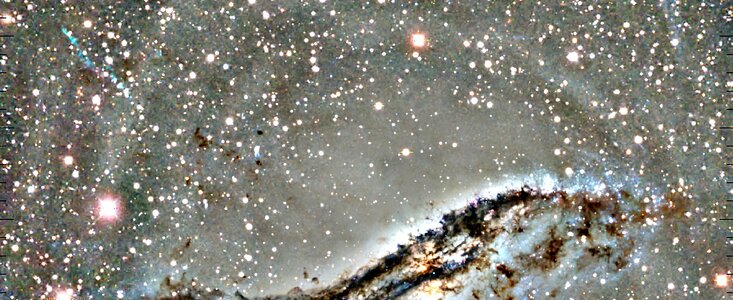Arc of Blue Stars a Lingering Sign of Shredded Dwarf Galaxy
15 October 2002
An unobtrusive arc of blue stars stretching above the iconic galaxy Centaurus A represents the lingering signature of an episode of galactic cannibalism that is surprisingly recent and, astronomically speaking, quite nearby.
Several complementary observations from the National Science Foundation’s Blanco telescope provide compelling evidence that massive Centaurus A ripped apart and swallowed a dwarf irregular galaxy only 200-400 million years ago, leaving behind an arc of young stars stretching at least 2,000 light-years. This finding adds to emerging evidence that smaller galaxies may be significant contributors to the formation of galactic halos, the outer perimeters of galaxies where stellar populations are sparse.
“The tidal forces of the main galaxy caused a burst of star formation within the infalling galaxy, and what we see now are these young stars spread along the remnant of the incoming orbit,” explains Eric Peng, a graduate student at the Johns Hopkins University in Baltimore. “Though it might appear to be a secondary feature in the complex neighborhood of Centaurus A, this tidal stream is a really sharp illustration of the ongoing process of galactic evolution.”
The arc had been noted as an unusual feature in earlier photographic plates of the violent maelstrom surrounding Centaurus A (also known as Cen A and NGC 5128). However, Peng and his collaborators decided to search for evidence of dwarf-sized fragments near the galaxy by using the powerful ability of modern digital imaging instruments to measure subtle differences in color. This made it possible to isolate the arc, and then to determine its youthful age and dynamic history from independent lines of evidence.
The Blanco 4-meter telescope at Cerro Tololo Inter-American Observatory (CTIO) near La Serena, Chile, has helped astronomers make several important insights into Cen A since the early 1970s, from the existence of a faint visible light jet to its complex exterior shell structure.
Peng and collaborators Holland Ford of Johns Hopkins, Ken Freeman of the Australian National University, and Rick White from the Space Telescope Science Institute used the Blanco telescope and its NOAO Mosaic II camera to study the stellar content of Cen A via optical maps in several color bands. These maps can then be stacked against each other to highlight subtle features.
“It was striking how this one arc feature really stood out,” Peng says, “which suggested strongly to us that it had a different origin from its surroundings.”
The wide field-of-view of the Mosaic camera on the Blanco matches up extremely well with the Hydra-CTIO spectrograph, which was used to confirm that a representative star cluster in the image is associated physically with the blue arc and Cen A, rather than being a foreground cluster in the Milky Way.
The spectroscopic data yielded an age for this cluster of approximately 350 million years. Further analysis of the color maps yielded an integrated age for the stream of about 200-400 million years, consistent with a separate estimate for the disruption of the stream based on its physical dynamics.
“We propose that the stream was formed from a tidally triggered burst of star formation that occurred when the dwarf galaxy fell into Cen A about 300 million years ago, which is interesting because it adds to evidence seen in the Milky Way and M31 that galactic halos are built up from the accretion of dwarf satellites,” Peng explains. “However, most of these examples involve older stellar populations in gas-poor dwarf galaxies, whereas the one we’ve observed in Cen A has young stars. This shows that younger, gas-rich dwarfs also fall into galaxies, which has never been seen clearly.”
The stars and star clusters from this tidal stream will eventually disperse into the main body of the galaxy, suggesting that the late infall of gas-rich dwarf galaxies plays an important a role in the build-up of stellar halos, Peng says. This process was likely much more common in the early universe.
“This result demonstrates how wide-field CCD cameras are breaking new ground in areas recently dominated by photographic techniques—digital processing played a critical role in this discovery,” explains CTIO Staff Scientist Knut Olsen. “The arc of young stars in Cen A is the closest such feature that we are likely to see the in local universe, so it provides a natural means to study the formation of the stars and star clusters that populate galaxy halos today.”
Located only 10 million light-years from Earth, Cen A is a peculiar-looking galaxy with an extremely dark and wide central dust lane. The combination of this lane and the galaxy’s exterior shell structure implies strongly to astronomers that it is the product of a violent merger between an elliptical galaxy and a smaller companion spiral galaxy.
The results from Peng, et al., have been accepted for publication in the December 2002 issue of the Astronomical Journal.
Notes
CTIO is part of the National Optical Astronomy Observatory, Tucson, AZ, which is operated by the Association of Universities for Research in Astronomy (AURA), Inc., under a cooperative agreement with the National Science Foundation.
Links
- A colorful image from their data that readily shows the blue arc is available above.
- A Hubble Space Telescope Image of Cen A with an inset wide-field image from CTIO.
Contacts
Douglas Isbell
Public Information OfficerNational Optical Astronomy Observatory
Tel: 520/318-8214
Email: disbell@noao.edu
Michael Purdy
Johns Hopkins University News Office
Tel: 410/516-7906
Email: mcp@jhu.edu
About the Release
| Release No.: | noao0210 |
| Legacy ID: | NOAO 02-10 |
| Name: | Centaurus A |
| Facility: | Víctor M. Blanco 4-meter Telescope |
| Instruments: | Mosaic I |
| Science data: | 2002AJ....124.3144P |



